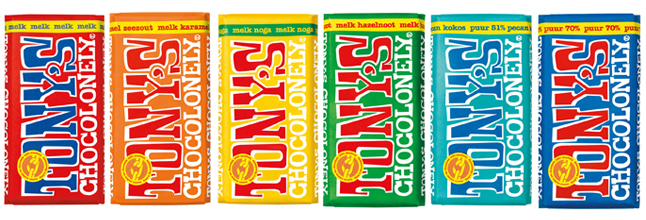
If, like many of our blog readers, you a) live in Portland, and b) love chocolate, you may have noticed a new brand on the shelves. Rocking bright, technicolor wrappers, and adorned with the chunkiest 70s-throwback font imaginable, Tony’s Chocolonely makes a bold statement. But it’s not just a matter of appearances—the Netherlands-based company is singularly dedicated to transforming its industry by putting an end to the abominable practice of child slavery, which accounts for so much of the low-priced chocolate found in stores around the world.
How is the company achieving its mission while scaling with authenticity? And what can other members of the food and beverage industry with an eye towards change learn by example?
To get a sense of the answers, I sat down with Peter Zandee. Peter is Tony’s Chocolonely’s U.S. sales manager, and has been playing a leading role in expanding the company’s presence here in the States.
We spoke about the company’s unique beginnings, its plans for expansion, and its ambitious mission. And, because Tony’s Chocolonely and Grady Britton are both B Corps, we also talked about corporate responsibility movements in broad terms: what it takes to get a movement off the ground, how they impact consumer behaviors, and Peter’s thoughts on the future of various trends and labeling campaigns.
This interview has been edited and condensed for clarity.
MORGAN RIDER: Tony’s Chocolonely has been around for over 10 years in the Netherlands, but just recently established its U.S. headquarters here in Portland. Can you give us some background on the Tony’s history—what you do and why you do it?
PETER ZANDEE: We were started ten years ago. There is a food TV show in the Netherlands called “Keuringsdienst van Waarde”—in the U.K. it’s called “Food Unwrapped.” They look into food products and into issues in the supply chain of these products. A little over ten years ago, they started looking into the slavery issues in the cocoa industry in West Africa, and found that the chocolate companies weren’t doing much, even though they had committed to do so by a senate protocol that they had signed in 2001.
So child slavery was an open secret.
Yeah. The issues with slavery in the cocoa industry were well known. In 2001, Senators Harkin and Engel created a protocol to eradicate child slavery in the cocoa industry in West Africa. All the large chocolate companies signed the protocol. And so in 2005, this Dutch TV show started digging and found that too little was really being done—
Despite the protocol.
Yeah, obviously, none of these companies wanted to make any statements on TV. Then, after consulting with some legal experts the journalist decided to eat chocolate and turn himself into the police—because, in Holland, if you buy a stolen bicycle, you’re an accomplice to the crime if you buy it knowing that it was stolen. Eventually the judge did not convict him because he didn’t want to convict every single Dutch chocolate consumer, and [the judge] couldn’t prove a direct link between the bars that he had eaten and the child slaves that came in to testify.
This lack of traceability is a critical issue in the industry. There are millions of farmers, but only a handful of global companies that process the cocoa. And there’s no traceability, really, in that supply chain. They never really knew where an issue on a farm would be: how the beans are harvested, or where that chocolate would end up—like, which brands?
After [this journalist] wasn’t convicted, Teun (aka Tony) decided to make 5,000 chocolate bars just to show that he could make slave-free chocolate. 15,000 people in Holland signed up online the first day to buy the chocolate bars. After that they decided to make a company of it.
Since then, our mission has been to create a 100% slave-free chocolate industry, not just our chocolate but all chocolate worldwide.
What exactly is, from a consumer perspective, fair trade versus slave-free?
Fair trade is a great first step, but it doesn’t guarantee slave-free. Fair trade technically doesn’t allow slavery either, but there isn’t sufficient enforcement of the fair trade rules. Unfortunately, we can’t necessarily guarantee 100% slave-free. For example, a couple of years ago, we found some issues on one of our farms. But, in our case, we try to be much more present locally and address issues when they come up. Our focus is on the eradication of child slavery.
So what percentage of fair trade chocolate now do you think is still being produced using slavery?
It’s impossible to say, because when you’re buy fair trade chocolate it’s not necessarily fair trade beans that are in that chocolate. Just like when you buy wind energy from the energy company, you’re not really buying–
…A light powered by a turbine?
Yeah. So for cocoa, it’s the same. All the cocoa beans basically go to just a couple big cocoa traders and producers. They buy a certain percentage of their beans fair trade and they sell a certain percentage of their beans fair trade. But the beans sold are not necessarily truly fair trade beans. In our case they are, because we have that traceability in our process. We know who our farmers are. Over 60% of the world’s cocoa comes from West Africa—from Ghana and the Ivory Coast—and there are almost two million children working there under illegal circumstances.
That’s awful.
And the situation is only getting worse according to some of our latest reports—one in particular by Tulane University.
What is the tenure? Do the kids escape? How long do they stay working in the fields?
That’s a good question. I don’t know. Sometimes these kids can be as young as maybe seven or eight years old, and it goes up to eighteen or so—that’s when they’re considered to be no longer children. When we talk about child slavery, it’s not just the people that are trafficked and bought and sold and kept. The official definition of modern slavery, when it applies to the cocoa industry—and this comes from the U.N. as well as the local governmental level—is children who are not allowed to go to school or, who do work under dangerous circumstances. Also the children who are trafficked are part of that, but it’s a much bigger group than children that are truly trafficked.
There are a lot of families whose children work on their farm, and that’s okay by us as long as they go to school and don’t do dangerous work. When they’re not allowed to go to school and do dangerous work, it becomes an issue.
You’re working now with farmers around West Africa.
We work directly with the farmers. In a sense we are a bean to bar company. We know who the farmers are, we go there, we work with local organizations that are at the co-ops regularly.
Do you think those farms perform better, have better employees, or better quality of life? Is there incentive for other farmers?
Well, we start by paying 25% more than what the price is on the world market, and that’s already considerably higher than the fair trade premium. So that helps. We do a lot of education, not only around child slavery, but trying to help them become more productive farmers. Both elements are necessary to really lift them out of poverty. We’ve done research on what we think is a living wage, and we think we should increase our premiums even a little more than where we are at right now, but we do also calculate into that equation the fact that the farmers need to become somewhat more productive. So that’s also what we are helping with.
According to your annual FAIR report, setting an example as a business is an important measure of your success. What does it take to inspire other chocolate companies to commit to slave-free chocolate?
When we started in Holland, there were basically no fair trade chocolates. Now, pretty much everybody there is fair trade. We have a three-stage road map: The first stage is creating awareness around the issues in West Africa. The second stage is “lead by example,” which you can read about in our annual report. Leading by example basically means that we’ve worked to set up a process of sourcing that we think would eradicate child slavery if everybody were to follow that.
So it could be replicated on a massive scale?
Yes. That has always been very important to us. Instead of working directly with farmers on a smaller scale, what we have done is that we’ve worked with one of the largest chocolate processors in the world and created traceability in our entire supply chain. And because we do it with one of the largest cocoa processors in the world, we know that this can be replicated, that Mars, or Hershey’s, or Mondelez, or Nestle can do it too. It’s always been important for us to show that we can be socially responsible and commercially successful, and that our process is scalable so other companies can do it too.
The third stage is “inspire to act.” That’s where we are now, especially in Holland, where we are trying to motivate other companies to follow our lead and work together with them on some of these items. They’re slowly starting to pop up: some other initiatives that basically are taking the lead from our book.
It must be difficult to scale and still keep traceability and control.
It’s important to grow but we don’t want to go too fast necessarily because at the end of the day we need to tell the story. That’s why we initially focused on Portland and tried not to go to too many geographic areas right away. Now we are looking to expand, but we’ll never grow big enough to solve the problems by ourselves. At some point, hopefully, other companies will follow. I don’t know where the tipping point will be, but it’s amazing to see how everybody we work with is excited about it.
I think what you guys do well is you do provide that hope and you can show that there is an alternative way, and it’s a good way.
Yes, it is hopeful, the fact that we do offer a model that we really think that could solve the slavery issue to a large extent, and that’s gainable, and that companies like Mars and Hershey’s could deduct. I’m hoping that makes it also easier for politicians or the legal system to say, “Hey, you know what? It is possible.” So you really don’t have an excuse not to go down that path.
—
Stay tuned to our blog for the second and final part of this interview, wherein Peter and I discuss topics such as consumer education and “label bingo,” coming soon!
